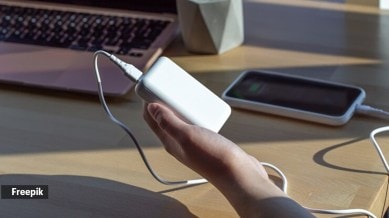📣 For more lifestyle news, click here to join our WhatsApp Channel and also follow us on Instagram
‘You can carry, but not charge’: Why passengers are prohibited from using power banks on flights
At cruising altitudes (~35,000 ft), aircraft cabins experience lower air pressure than at ground level

Not allowed in checked-in baggage, portable chargers or power banks are strictly to be carried in hand baggage on flights. But have you ever wondered why you are not allowed to use these electronic devices, even though you have them with you? To gain a deeper understanding, we consulted Dr. Harshada Babrekar, Ph.D., a physics consultant at Maharashtra Knowledge Corporation Limited (MKCL), who explained that these compact devices are designed to store electrical energy and transfer it to mobile devices, much like depositing and withdrawing money from a bank.
“You can carry, but not charge, because they consist of a rechargeable battery housed in a protective casing, along with circuitry that regulates power flow. These devices are especially useful when access to wall outlets is limited,” said Dr Babrekar.
monthly limit of free stories.
with an Express account.
Most power banks use lithium-ion (Li-ion) or lithium-polymer (Li-Po) cells. A Li-ion battery stores and releases energy using lithium ions. It has three main parts, viz, Anode (negative side), Cathode (positive side), and Electrolyte (a liquid or gel that helps ions move).
When the battery is discharging (powering a device): Lithium ions move from the anode to the cathode through the electrolyte, explained Dr Babrekar adding that electrons flow through the external circuit, creating electricity that powers the device. “This process is stable under normal conditions, but if the battery is damaged, overcharged, or short-circuited, the chemical balance can collapse,” he told indianexpress.com.
This thermal runaway is a self-sustaining chain reaction where rising temperatures trigger chemical reactions that produce more heat, ultimately leading to fire, explosion, and the release of toxic gases. “It can be initiated by overcharging, physical damage, manufacturing defects, or exposure to high external temperatures. Once started, the reaction can quickly escalate,” said Babrekar.
Simply put, at cruising altitudes (~35,000 ft), aircraft cabins experience lower air pressure than at ground level. So, gases expand more under reduced pressure, which means that they can rupture the casing, leading to an explosion. “Even a minor internal short, caused by impurities or damage, can escalate into an explosion under these conditions,” said Babrekar.
This is why flight attendants discourage the use of portable chargers during a flight.
“While power banks are convenient, they carry inherent risks. Understanding how thermal runaway occurs and how environmental factors like altitude and poor ventilation contribute to battery failure is crucial, especially in sensitive settings like aircraft cabins. Proper handling, quality components, and awareness of these risks can help prevent dangerous incidents,” said Babrekar.
DISCLAIMER: This article is based on information from the public domain and/or the experts we spoke to. Always consult your health practitioner before starting any routine.
📣 For more lifestyle news, click here to join our WhatsApp Channel and also follow us on Instagram